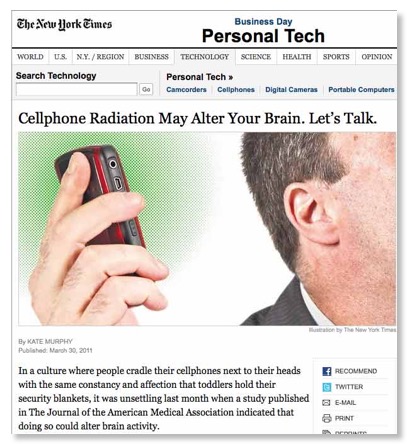CTIA: Maybe Your RF Safety PR Strategy Isn't Working?

Dear friends in the cellular industry,
While the above NY Times article today is not unprecedented and contains lots of garbles and misinformation, it might be time to think about whether the PR strategy of the cellular industry on RF safety needs review. While the ongoing tragic events in Japan are totally unrelated to the cellular RF safety issue, they may cause growing public distrust in government and industry when they say everything is safe.
The basic view of the cellular industry is that cell phones meet government safety standards and that is all you need to know. Trust the government and trust the cellular industry. That is the mantra. I don’t know what newspapers the leaders of the cellular industry read, but I get the distinct impression that “outside the Beltway” trust in the government is decreasing for a variety of reasons and certain radio/TV personalities and politicians are capitalizing on the trend.
A decade ago the cellular industry fought hard to keep the SAR data for individual cell phone models buried in the the FCC lab’s web site where they were nearly impossible to find. Only forceful action by Chmn. Kennard was able to bring about the current policy where SAR data availability made simple enough for other websites to collect it en masse for posting for the public.
Does SAR data for a given phone give the whole picture of cell phone safety? No. Other factors matter including how one holds the phone and the coverage of the cellular operators (“more bars in more places”). Indeed, the general trend towards smart phones and the decrease in total voice minutes means that the total RF exposure of the US public is probably decreasing since the usual SAR number is based on a handheld cellphone held next to the head for a voice call.

Wikipedia photo
CTIA staff are also not returning calls or e-mails from your blogger - I really don’t try to contact them very often. Perhaps I have been labelled an Ibsen-esque “Enemy of the People” in their hallways - even though I sided with them over NAB on the “FM radio in cell phone” issue.
I have repeatedly contrasted the position of the US industry with that of AFOM (now called La Fédération Française des Télécoms Collége Mobile), CTIA’s French counterpart. Their RF safety website has pragmatic information about RF safety and steps one might take to decrease exposure - not stonewalling about “trust government and industry”. One source in US industry told me that a reason for the current position is to limit liability if a health problem is ever found. If this is true, perhaps industry ought to get a “legal second opinion”.
Again, there is no known reason to believe that the moment that present cell phone use poses any safety problem and indeed total public exposure may be decreasing due to usage trends. But the certainty in this statement is not high enough to justify the industry’s present “stonewalling” posture. There is a reasonable middle ground. Maybe you should consider it.
UPDATE
| MAGAZINE |
On April 14, The New York Times posted a link to the above long article that will appear on Sunday.. The author, Dr. Siddhartha Mukherjee (smukherj2011@gmail.com) is an assistant professor of medicine in the division of medical oncology at Columbia University. He is the author of Emperor of All Maladies: A Biography of Cancer .
It is clear this controversy is not going away. Perhaps in keeping with their San Francisco strategy, CTIA will stop advertising in NYTimes and advise its members to do likewise.
I think better and realistic public engagement on the issue with pragmatic information on how to decrease exposure is a better policy. However, at present CTIA is focusing on its “Freedom is Wireless” campaign to make everyone feel good. Do they have the same PR firm as the American Petroleum Institute that wants you to feel their industry is also “touchy feely”?



![Validate my RSS feed [Valid RSS]](valid-rss-rogers.png)

